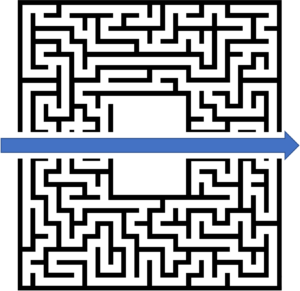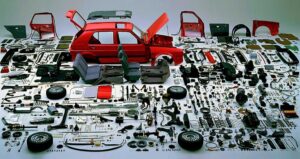For the last dozen or more years, id3as has been in the business of building custom live streaming workflows for the likes of Nasdaq, Notified, DAZN, Arqiva, and Stats Perform. This blog talks about why we are passionate about custom workflows and why, with the launch of the Norsk, we are so excited to be putting the power behind those solutions directly into the hands of customers.
But let’s start with an exploration of what a custom workflow looks like and why you might want one. We’ll do that by looking at the use case of financial fair disclosure (FFD) streaming, and in particular our experience with Nasdaq, which delivers upwards of 100,000 FFD live events a year.
When You Have a Hammer, Everything Looks Like a Nail

Not long before they started working with id3as, they had gone to market for a tech refresh of their video event capability.
And what they saw in the market was a number of products offering “source in, ladder out.” Send a source from the venue and those products will encode it into various bitrates (the “encoding ladder”) and forward it to various CDNs. They even produce on-demand assets as part of the process.
The market had that capability. It matched their needs. Great!
So they implement source in, ladder out, along with a very clever field encoder with hundreds of settings and very clever central encoders that build the ladders, publish the live streams, and generate on-demand copies of everything. Very clever.
The Live Streaming Simplicity Illusion
 Here’s the problem: Source in, ladder out really isn’t what financial fair disclosure is about. Source in, ladder out is just what everything looks like when source in, ladder out is the “hammer” at your disposal.
Here’s the problem: Source in, ladder out really isn’t what financial fair disclosure is about. Source in, ladder out is just what everything looks like when source in, ladder out is the “hammer” at your disposal.
[An important detour from the story: I’m not saying the tools available are bad, or that off-the-shelf is not sometimes the right answer. There are many amazing live streaming tools in the marketplace. If they fit your needs exactly, they’re exactly what you should use!]
So what is financial fair disclosure all about? What is important to Nasdaq customers?
- First and foremost, they are fulfilling a legal obligation not to unfairly disadvantage potential investors.
- They are maintaining a relationship with customers and the wider market. They need to get feedback from investors both during and after events.
- They need to understand what message the audience heard. How did it go down? Did it have the desired impact in terms of share price, brand values etc?
- And finally, did the CEO look their sparkling best?
And what is important to Nasdaq? Delivering the above to their customers, with great quality, around 100,000 times a year.
And that volume is a major part of the simplicity illusion. Doing something that frequently is a fundamentally different challenge than doing so for a one-off event.
It will come as no surprise that historically the single biggest pain point was reliability of the signal from the event. Sure, the network was stable when the crew tested it all yesterday, but now with 2,000 people in the room onsite, it doesn’t seem quite so great.
And in a financial disclosure event, what’s the most important thing? Is it the lovely shot of the CEO at their sparkling best? Or is it the words? And the slides? And the carefully timed release of the market-sensitive data? And the ability to do this flawlessly, time and time and time again, even if your cloud provider is having a bad day?

So what started life seemingly as a “source in, ladder out” slam dunk, really wasn’t. Instead it was a case of “Use video source 1 if you can. If not, use source 2 (sent over a completely different network). And let’s make a phone call to the venue so that even if the internet is down entirely we can still broadcast the audio over a customer-specified image. And let’s be able to patch in trailers and promotional videos. And let’s add timecodes into the signal so we can sync accurately with the slides and data release points. And … And …”
And let’s do that flawlessly 100k times a year. With minimal human intervention.
So let’s just pop to the shops and pick one of those up.
Except, of course, there isn’t “one of those.” And even when there is a high-end solution in your space, it’s likely to come with quite the price tag and quite the integration project. We spoke to the CTO of a large regional sports broadcaster just a few weeks ago, and they bemoaned the amount of time and money they were having to spend trying to customize off-the-shelf solutions to meet their needs.
So when the fit you want doesn’t exist, what do you do?
The Roll-Your-Own Live Streaming Workflow Trap
So you roll your own and you build a solution from scratch. And of course, that diverts even more resources—time, money, staff—from your core business.

And when you’re done, congratulations! You used to be a stock exchange (or a sports broadcaster or a fitness studio or …), and now you’re a media technology company.
That works for the very biggest of companies, but even then it really isn’t their core business. Still, because they’ve written hundreds of thousands or even millions of lines of code it’s easy for it to become part of the corporate identity, leading to …
The Live Streaming Differentiation Fallacy
And the problem is that nobody outside the streaming media industry cares.
Floated companies care about clear communications with investors and the markets. They care that they meet their legal obligations.

Sports broadcasters care about your compelling viewing experiences. They care about rights management. They care about the communities they build with fans.
No consumer in their right mind is interested in the technology used to print Popeye’s spinach labels—they are interested in the strength, health, and happiness that consuming the spinach delivers.
Similarly, not one consumer cares whether we use NV12 or YUV, or whether we use HLS or DASH. They care how entertaining it is, what it looks like, whether they can interact with their peer group, how much it costs, how reliable it is, how interactive and informative it is, etc.
When Major League Baseball built what became BAMTECH, it was the viewer experience that set them apart from the other sports leagues. That viewer experience may well have been enabled by technology choices, but it is the experience—not the technology—that matters. 
And the problem is that, in a roll-your-own world, for every line of code describing your wonderfully differentiated business process—your amazing viewer experience—you probably have hundreds or even thousands of lines of media technology code.
So what did Nasdaq do? They chose id3as, a company foolish enough to have our own “roll your own” tech stack. We implemented their business rules, and they saw the number of errors in their webcasts plummet. At the same time, the number of events that their existing call center could monitor increased immensely.
id3as is able to keep tailoring our solution so that Nasdaq keeps a sustained market advantage.
So Nasdaq lived happily ever after, right? The End?
While the above is all true, it is not and should not be the end of the story. id3as has some exceptional technology, and we are very unusual in being in the business of customizing media workflows. We work on hugely interesting projects, solving meaningful and hard challenges for our customers. We enable some really compelling viewer experiences and implement our customers’ core business processes for them.
And therein lies the problem. Why is core customer IP gated behind id3as’ (or indeed anyone’s?) technology and our ability to react to client needs?
It doesn’t have to be like that!
A Lesson from the Retail Industry
I started my IT career in retail, building very large-scale electronic point-of-sale systems. Back then every major retail system came with its own proprietary database to store prices and item descriptions and to hold details of the transactions made.
Those proprietary databases were part of the cost of doing business. They were complex and required people with highly specialist knowledge to build and maintain them. Only companies with the deepest of pockets could afford to build one.
And not one retailer on the planet cared whether their sales reports came from balanced b-trees or prefix-free crit-bit trees, or radix trees or keyed files. They cared that their sales reports were timely and accurate. They cared that they could deliver great pricing to their customers. They cared that they worked with brands and promotional schemes that resonated with their audience.
But that differentiation was gated behind deep knowledge of database technologies and vast amounts of code written in C or even assembler.
That gating was unlocked by the advent of commoditized databases that slashed development costs and timescales. Companies could focus on the important stuff rather than unavoidable, hugely complicated, but ultimately undifferentiating technology.
We believe media technology is poised at a similar threshold. One that allows companies to control their own IP while building even the most complex of workflows. We have poured tens of developer-years into building Norsk, a low-code live streaming SDK that allows you to describe, implement, and update even the most complex live streaming workflows—all in just a few lines of code, using the programming languages your teams are already familiar with.
Under the covers there is immense complexity, but just as with well-implemented databases, you can leverage the value without having to understand this complexity.
Norsk is the media technology expert so you don’t have to be.
We, Not You
At IBC, we showed Norsk to one of our existing customers. They got really excited and asked lots of “Does that mean you could do X for us?” questions. The answer to which was, “Yes, of course.” But then that changed. Suddenly they stopped saying “So you could …” and started saying “So we could …”
 And that, in a nutshell, is what Norsk is all about—freeing you from the limitations of the simplicity illusion and removing the tyranny of “roll your own” complexity. It opens a world in which you can build amazing live streaming experiences with a few dozen lines of simple code, and where the focus is not on technical details but on value to your customers.
And that, in a nutshell, is what Norsk is all about—freeing you from the limitations of the simplicity illusion and removing the tyranny of “roll your own” complexity. It opens a world in which you can build amazing live streaming experiences with a few dozen lines of simple code, and where the focus is not on technical details but on value to your customers.
A “source in, ladder out” implementation probably requires less than 10 lines of code. Start there and evolve the solution in small manageable steps as you see the ways in which you can differentiate and add value to your customers.
One of the sample projects that comes with Norsk builds a mosaic output from various sources as they come and go. That comes in at a little over 100 lines of code. More code than the simple ladder, for sure.
But it’s almost all business code: How do I decide if I should accept a new connection? If so, where in the mosaic should it be placed? What should I do if a connection drops? Remove it? Replace the video with “Fred will be back soon?” End the event entirely?
It is your control over this business logic that means you end up with a live streaming workflow that embodies your business logic—your process. That’s what enables consistent quality and a compelling user experience for your audience.
If you want to learn more we strongly encourage you not just take our word for it. Contact us for a demo, or just go ahead and download a trial license and get to work seeing how Norsk Makes Live Easy.
